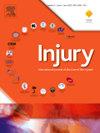Attributable risk factors and trends in global burden of falls from 1990 to 2021: A comprehensive analysis based on Global Burden Of Disease Study 2021
IF 2.2
3区 医学
Q3 CRITICAL CARE MEDICINE
Injury-International Journal of the Care of the Injured
Pub Date : 2025-03-24
DOI:10.1016/j.injury.2025.112296
引用次数: 0
Abstract
Background
Falls are a leading cause of disability-adjusted life years (DALYs) and mobility difficulties. Previous estimates have relied on restricted regional scope and lack a thorough global study. This study, for the first time, examines the evolving trends in the global burden of falls from 1990 to 2021, focusing on geographic variation in disease burden and risk factors, predicting the development of burden of falls. Our aim was to provide information for allocating medical resources, taking health policies into action, and making patient management systems operate better.
Method
Data on incident cases, deaths, and DALYs were collected for countries, regions, ages, and sexes worldwide from the Global Burden Disease (GBD) 2021 database. Using R (version 4.3.2), we calculated estimated annual percent changes (EAPCs) for assessing trends in age-standardized rates, visualized risk factors, and predicted the global burden of falls. Joinpoint regression (version 4.9.1.0) was used to identify significant temporal trends and change points.
Results
In 2021, 548.8 million people were affected by falls. There were 215 million incidence, 43.8 million DALYs, and 800,000 deaths caused by falls. The incidence rate of falls increases with age, and sex inequalities exist. Compared with 1990, the age-standardized incidence rate (ASIR), death rate (ASDR), and DALY rate (ASDALYsR) declined despite an increase in absolute numbers. The ASDR and ASDALYsR of falls are expected to decline in the future, whereas the ASIR is expected to rise. The fall burden varied significantly according to region and its sociodemographic index (SDI). Both ASIR (R = 0.510, p < 0.001) and ASDALYsR (R = 0.2762, p < 0.001) were positively correlated with SDI. In contrast, ASDR (R=-0.536, p < 0.001) showed a consistently negative association with SDI. Low bone mineral density, occupational injuries, alcohol use, and smoking emerged as the top factors associated with fall-related DALYs and deaths.
Conclusions
The overall burden of falls declined between 1990 and 2021, but the future incidence is expected to increase. The global burden of falls remains unchanged and shows significant regional and sex-based differences. Effective prevention and strategies against risk factors are imperative for reducing the future burden.
求助全文
约1分钟内获得全文
求助全文
来源期刊
CiteScore
4.00
自引率
8.00%
发文量
699
审稿时长
96 days
期刊介绍:
Injury was founded in 1969 and is an international journal dealing with all aspects of trauma care and accident surgery. Our primary aim is to facilitate the exchange of ideas, techniques and information among all members of the trauma team.

 求助内容:
求助内容: 应助结果提醒方式:
应助结果提醒方式:


